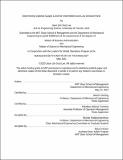Determining Optimal Supply Level for Intermittent and Low Demand Parts
Author(s)
Lee, Jason (Jin Soo)
DownloadThesis PDF (1.407Mb)
Advisor
Seering, Warren
Trichakis, Nikolaos (Nikos)
Terms of use
Metadata
Show full item recordAbstract
One of the challenges in the heavy equipment aftermarket business is determining what optimal level of supply looks like for intermittent and low demand parts. For these parts, it is difficult to forecast the needed demand and set the right amount of inventory level. A number of these parts are Made-as-Order (MAO) with long lead times, therefore when a part is needed, customers may need to wait up to several months to receive the part. Thus, there is potential for negative impact on a heavy equipment manufacturer’s brand image and customer relationships.
The goal of this project will be to determine the optimal inventory strategy for these parts and evaluate the impact on Caterpillar’s value stream. This requires a balance between maintaining reasonable level of inventory and ensuring customers receive the parts in a reasonable amount of time. In determining the optimal level, the company would be able to achieve savings in inventory costs and improve brand reputation and customer relationships due to better availability.
The project will disseminate the issue into four steps: 1) understand the demand profiles and segment the parts into granular categories, 2) calculate inventory level based on various inventory strategies, 3) select the optimal inventory strategy, and 4) evaluate the performance of selected strategy. From evaluating various demand profiles, low and intermittent demand parts will be segmented further into granular categories to ensure flexibility in their inventory strategy. For each category, inventory levels will be calculated using various inventory models. Then, based on probability of demand, profitability of the part, and holding/opportunity costs, an optimal inventory strategy will be built around maximizing profit and service levels. This optimal strategy will be evaluated based on a number of metrics (financial and reputational) to determine its performance against current inventory model within various scenarios.
For low and intermittent demand loader and scraper family parts (~5,600 parts and ~6,800 parts respectively), the model showed close to 20% improvement in profitability and 40% improvement in service level over Caterpillar’s current inventory strategy.
Date issued
2021-06Department
Massachusetts Institute of Technology. Department of Mechanical Engineering; Sloan School of ManagementPublisher
Massachusetts Institute of Technology